- Caused by Tectonic Movements – Most earthquakes occur due to the movement of tectonic plates beneath the Earth's surface.
- Measured by Seismographs – Scientists use a device called a seismograph to detect and record earthquake vibrations.
- Magnitude and Intensity – The strength of an earthquake is measured on the Richter Scale, while its effects on people and structures are measured by the Mercalli Scale.
- Epicenter and Focus – The focus (hypocenter) is the underground point where the earthquake starts, while the epicenter is the point directly above it on the Earth's surface.
- Aftershocks – Small tremors often follow a major earthquake and can cause additional damage.
- Tsunamis – Underwater earthquakes can trigger tsunamis, which are large, destructive ocean waves.
- Types of Earthquakes- tectonic (caused by plate movements), volcanic (linked to eruptions), collapse (due to cave-ins), or induced (caused by human activities like mining or reservoir filling).
- Earthquake-Prone Areas – Regions near tectonic plate boundaries, such as Japan, Indonesia, and California, are more likely to experience earthquakes.
- Destruction and Damage – Earthquakes can destroy buildings, roads, and infrastructure, leading to loss of life and economic damage.
- Safety Measures – During an earthquake, Drop, Cover, and Hold is a key safety rule. Buildings in earthquake-prone areas should be designed with strong foundations to withstand shocks.
What is an Earthquake?
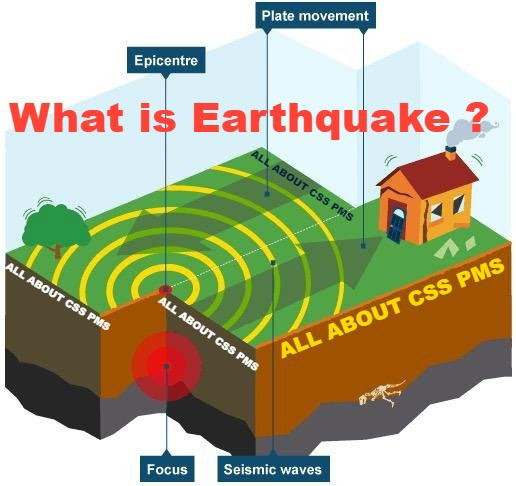
Introduction
An earthquake is a sudden and violent shaking of the Earth's surface caused by movements within the Earth's crust or volcanic activity. These natural disasters can occur without warning and may lead to severe destruction, loss of life, and environmental changes. Earthquakes vary in intensity and duration, ranging from minor tremors that go unnoticed to catastrophic events that devastate entire regions. Scientists use seismographs to measure earthquakes and the Richter scale to determine their magnitude.
Definition
It is defined as "the sudden release of energy in the Earth's lithosphere that creates seismic waves, resulting in ground shaking and potential surface rupture." This release of energy occurs due to the movement of tectonic plates, volcanic eruptions, or human activities like mining and reservoir-induced seismicity.
Or
"the sudden shaking of the Earth's surface caused by the movement of underground rocks or volcanic activity."
Earthquakes and volcanoes are examples of sudden movements which originate from inside the earth. It is the shaking of the earth. It can be defined as a sudden violent shaking of the ground as a result of movements in the earth's crust or volcanic action. These movements result in the release of energy along a fault and cause the earth to shake. An earthquake, like volcanoes is a type of endogenic processes.
Important Points :
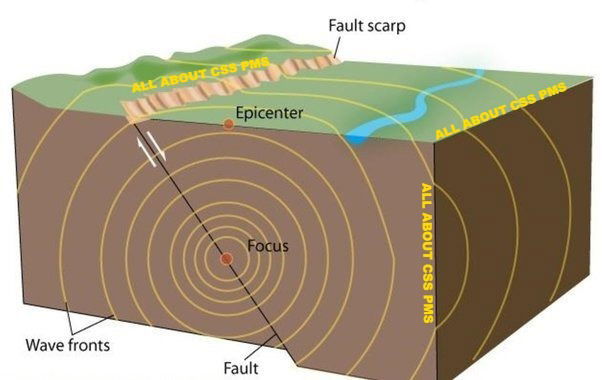
Earthquake waves or Seismic waves :
The earthquake which originates in the lithosphere propagates different seismic waves or earthquake waves.
Earthquake waves are basically of two types body waves and surface waves.
SEISMIC WAVES
| BODY WAVES | SURFACE WAVES | |||
|---|---|---|---|---|
| primary waves (P-waves) | secondary waves (S-waves) | Love waves (L-waves) | Rayleigh waves (R-waves) | |
Body waves :
- They are generated due to the release of energy at the focus and moves in all directions traveling through the body of the earth. Hence, the name -- body waves.
- They travel only through interior of the earth.
- Body waves are faster than surface waves and hence they are the first to be detected on a seismograph.
- There are two types of body waves as primary waves and secondary waves.
Primary Waves (P-Waves) :
- Primary waves are the fastest body waves (twice the speed of s-waves) and are the first to reach during an earthquake.
- They are similar to sound waves , i.e, they are longitudinal waves, in which particle movement is in the same direction of wave propagation.
- They travel through solid, liquid and gaseous materials.
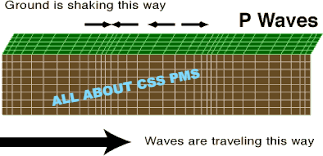
Secondary waves (S-waves) :
- They arrive at the surface with some time-lag after primary waves.
- They are slower than primary waves and can pass only through solid materials.
- This property of s-waves led seismologists to conclude that the earth's outer is in liquid state. (the entire zone beyond 105° from the epicenter does not receive S-waves).
- They are transverse waves in which directions of particle movement and wave propagation are perpendicular to each other.
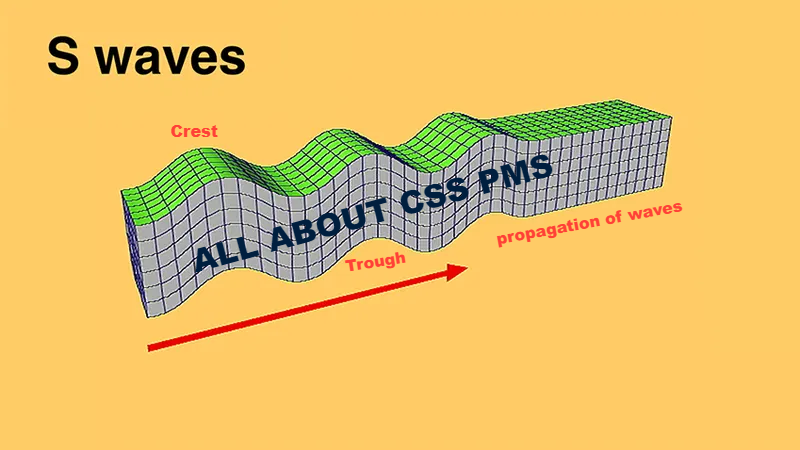
Surface Waves :
- When the body waves interact with surface rocks, a new set of waves is generated called as surface waves.
- These waves move along the earth surface.
- Surface waves are also transverse waves in which particle movement is perpendicular to the wave propagation.
- Hence, they create crests and troughs in the material through which they pass.
- Surface waves are considered to be the most damaging waves.
- Two common surface waves are Love waves and Rayleigh waves.
Love Waves :
- This kind of surface waves causes horizontal shifting of the earth during an earthquake.
- They have much slower than body waves but are faster than Rayleigh.
- They exist only in the presence of semi-infinite medium overlain by an upper finite thickness.
- Confined to the surface of the crust, Love waves produce entirely horizontal motion.
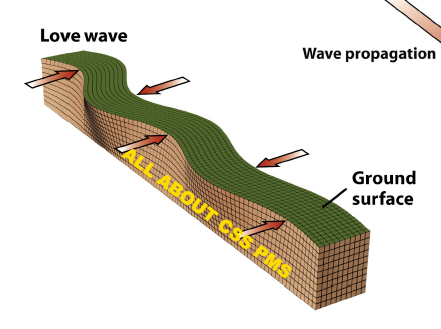
Rayleigh waves :
- These waves follow an elliptical motion.
- A Rayleigh wave rolls along the ground just like a wave rolls across a lake or an ocean.
- Because of rolls, it moves the ground up and down and side-to-side in the same direction that the wave is moving.
- Most of the shaking felt from an earthquake is due to the Rayleigh wave, which can be much larger than the other waves.
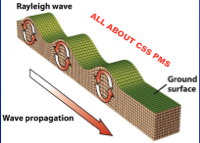
Shadow Regions of Waves :
- P-waves pass through all medium while S-waves passes only through solid medium.
- With the help of these properties of primary waves, seismologists have a fair idea about the interior of the earth.
- Even though P-waves pass through all mediums, it causes reflection when it enters from one medium to another.
- The variations in the direction of waves are inferred with the help of their record on seismographs.
- The area where the seismograph records no waves is called as 'shadow zone' of that wave.
- Accordingly, it is observed that the area beyond 105° does not receive S-waves and the area in between 105° to 140° does not receive P-waves.
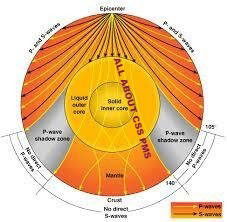
Measuring Earthquakes :
- Seismometers are the instruments which are used to measure the motion of the ground, which including those of seismic waves generated by earthquakes, volcanic eruptions, and other seismic sources.
- A Seismograph is also another term used to mean seismometer through it is more applicable to the older instruments.
The recorded geographical output from a seismometer/seismograph is called as a seismogram.
Seismograph is an instrument while Seismogram is the recorded output.
Mercalli Scale :
The scale represents the intensity of earthquake by analyzing the after effects like how many people felt it, how much destruction occurred etc. The range of intensity is from 1-12.
Richter Scale :
The scale represents the magnitude of the earthquake. The magnitude is expressed in absolute numbers from 1-10. Each whole number increase in Richter scale represents a ten times increase in power of an earthquake.
Distribution of Earthquakes :
There are two well-defined belts where earthquakes frequently occur --
- The Circum-Pacific Belt
- The Mid-World Mountain Belt.
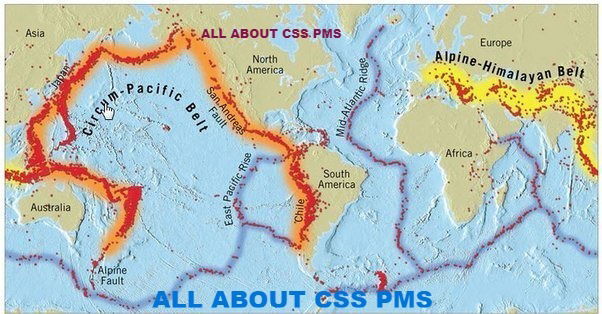
- About 68% of earthquakes in the world occur in the Circum-Pacific Belt.
- Mid -World belt extends from the Alps with their extension into Mediterranean, the Caucasus, and the Himalayan region and continues to Indonesia.
- 21% of earthquakes are occurring in this belt.
- The remaining 11% occur in the other parts of the world.
Terms Associated with Earthquakes :
Focus :
The place of origin of an earthquake inside the earth.
Epicenter :
- Point on the earth's surface vertically above the focus.
- Maximum damage is caused at the epicenter.
Wave Velocity :
5 to 8 km per second through the outer part of the crust but travel faster with depth.
Isoseismic Line :
A line connecting all points on the surface of the earth where the intensity is the same.
Human Induced Earthquakes :
Some earthquakes are human induced.
Earthquakes in the reservoir region, mining sites etc. are human induced.
Some Earthquake inducing human activities :
- Deep mining.
- Underground nuclear tests.
- Reservoir induced seismicity (RIS).
- Extraction of fossil fuels.
- Groundwater extraction.
- Artificial induction.
- In fluid injection, the slip is thought to be induced by premature release of elastic strain, as in he case of tectonic earthquakes, after fault surfaces are lubricated by the liquid.
Effects of Earthquakes :
- Earthquakes cause landslides, damming of rivers, depressions which form lakes.
- They can cause submergence and emergence of landforms along coastal regions. Example : Coastline of Kutch.
- Lead to surface drainage and underground circulation of water.
- More devastating features of earthquakes are fires and seismic waves (tsunamis).
- Formation of cracks or fissures especially in the region of the epicenter is common.
Types of Earthquakes :
- Tectonic Earthquake
- Explosion Earthquake
- Collapse Earthquake
- Volcanic Earthquake
Tectonic Earthquake :
The most common form of earthquake, is caused by the movement of loose fragmented pieces of land on the earth's crust known as tectonic plates.
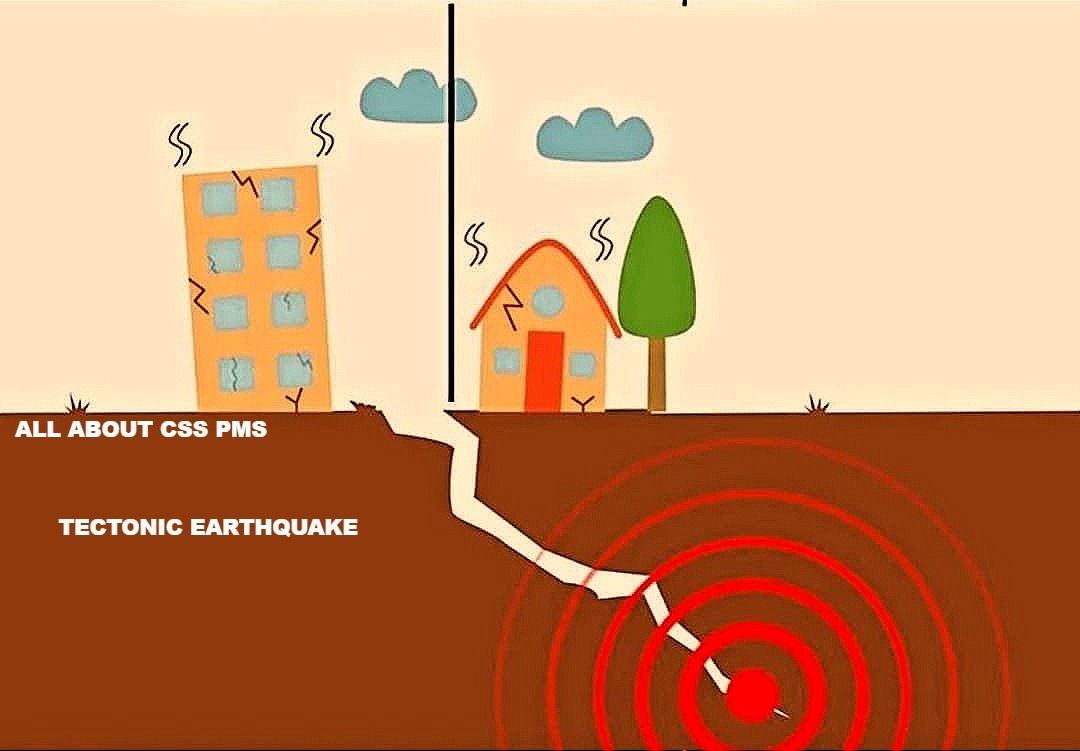
Explosion Earthquake :
The occurrence of this type of earthquake is artificial. High-density explosion such as nuclear explosions is the primary cause.

Collapse Earthquake :
This earthquake occurs in underground mines. The main cause is the pressure generated within the rocks.
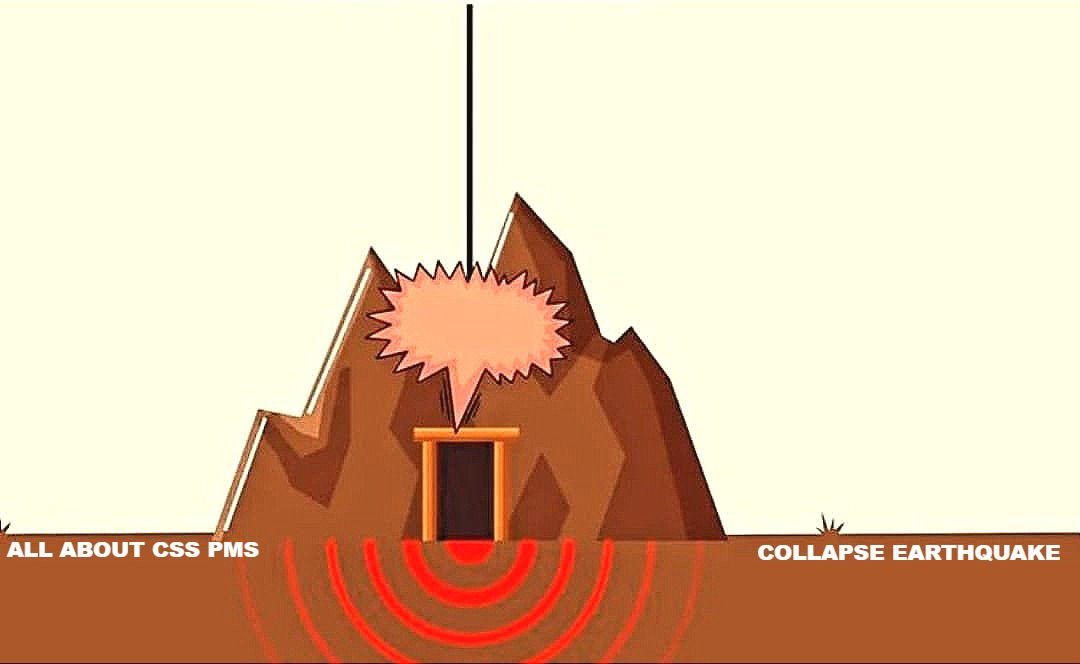
Volcanic Earthquake :
The less prevalent compared to the tectonic variety, these earthquakes happen before or after the eruption of a volcano.
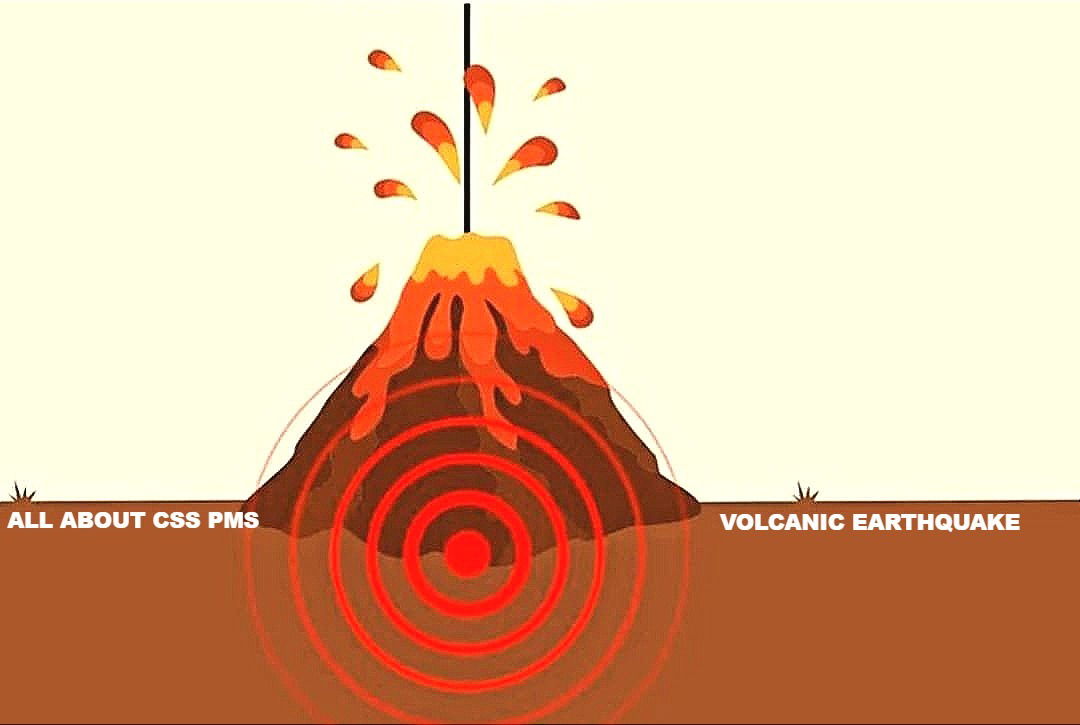
What to Do When an Earthquake Strikes
Earthquakes can happen anytime, anywhere, and without warning. When the ground starts shaking, stay calm and act fast. Follow the golden rule: Drop, Cover, and Hold On. Drop to your hands and knees to avoid being knocked over. Cover your head and neck under a sturdy table or against an interior wall. Hold on until the shaking stops. Avoid running outside—falling debris is a bigger threat than the quake itself. If you're in bed, stay there and cover your head with a pillow to protect yourself from falling objects.
If you're outside, move to an open area away from buildings, trees, and power lines. If you're driving, pull over safely and stay inside the vehicle. Once the shaking stops, stay alert—aftershocks can follow. Check yourself and others for injuries, avoid using elevators, and listen to emergency alerts. Preparedness saves lives, so always have an emergency kit with water, food, a flashlight, and a first-aid kit. Stay informed, stay prepared, and stay safe.
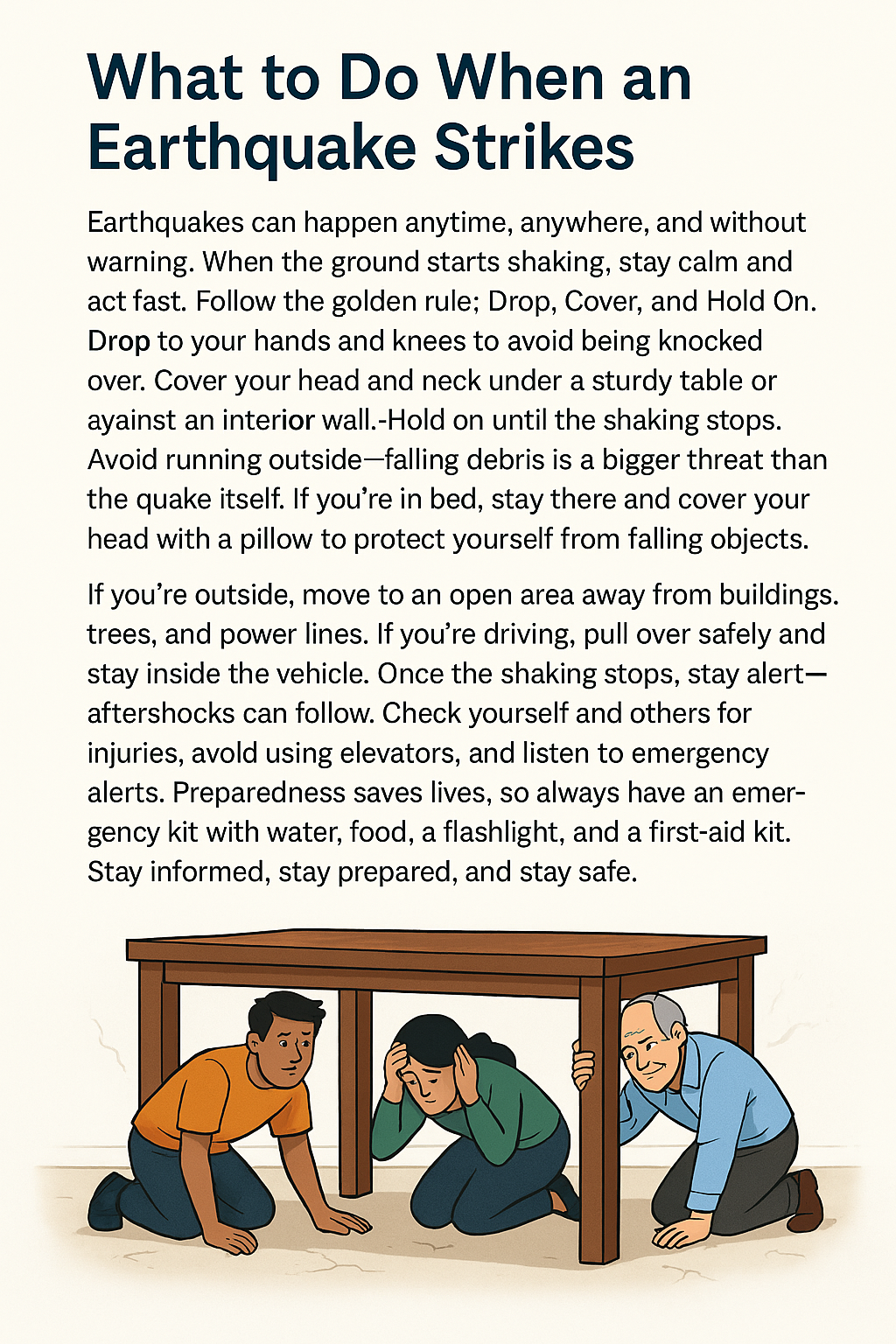
Major Earthquake Disasters Around the World
Earthquakes have caused massive destruction throughout history, affecting countries worldwide. Below are some of the most significant earthquake disasters:
1. United States – 1906 San Francisco Earthquake
One of the deadliest earthquakes in U.S. history, this 7.9 magnitude quake destroyed much of San Francisco, causing fires and over 3,000 deaths.
2. Japan – 2011 Tōhoku Earthquake and Tsunami
A 9.1 magnitude earthquake hit Japan, triggering a massive tsunami that killed nearly 20,000 people and caused the Fukushima nuclear disaster.
3. United Kingdom – 1931 Dogger Bank Earthquake
Though the UK is not known for large earthquakes, this 6.1 magnitude offshore quake caused minor damage in England and was one of the strongest recorded in the country.
4. Australia – 1989 Newcastle Earthquake
A 5.6 magnitude earthquake struck Newcastle, killing 13 people and causing significant damage, making it one of Australia’s most destructive earthquakes.
5. Canada – 1949 Queen Charlotte Earthquake
A 8.1 magnitude earthquake, the largest in Canadian history, hit British Columbia. Although it caused little damage due to its offshore location, it was a major seismic event.
6. China – 1976 Tangshan Earthquake
This 7.5 magnitude earthquake was one of the deadliest in history, killing around 242,000 people and devastating the city of Tangshan.
7. Nepal – 2015 Gorkha Earthquake
A 7.8 magnitude quake struck Nepal, causing landslides, destroying historical sites, and killing over 9,000 people.
8. Indonesia – 2004 Indian Ocean Earthquake and Tsunami
A massive 9.1 magnitude earthquake off Sumatra triggered a tsunami that killed 230,000 people across multiple countries, including Indonesia, Sri Lanka, and India.
9. Haiti – 2010 Earthquake
A 7.0 magnitude earthquake devastated Haiti, killing over 200,000 people and displacing millions due to poor infrastructure.
10. Turkey & Syria – 2023 Earthquake
A powerful 7.8 magnitude earthquake hit Turkey and Syria, killing over 50,000 people and leaving millions homeless.
11. Myanmar Earthquake March 28, 2025
The Ground Shook, and So Did Lives: Myanmar’s Powerful Earthquake Leaves Hundreds Dead
On March 28, 2025, Myanmar was rocked by one of the strongest earthquakes in its recent history. A powerful 7.7-magnitude earthquake hit near Mandalay, causing massive destruction, fear, and heartbreak across the country. The shaking was so strong, it was felt all the way to Bangkok, Thailand, where buildings swayed and even collapsed.
Where Did It Happen?
The US Geological Survey (USGS) reported the quake struck at 12:50 PM local time near Mandalay, one of Myanmar’s biggest cities, at a shallow depth of 10 kilometers — making the impact even worse. Just 12 minutes later, a strong 6.4 aftershock followed, adding to the fear and damage. Source: WSJ
Human Loss and Damage
According to official reports, at least 181 people have died and more than 1,500 have been injured. The hardest-hit areas include Mandalay, Sagaing, Bago, Naypyidaw, and parts of Shan State. Source: The Guardian
Many buildings collapsed — including hospitals, mosques, temples, and schools. One of Mandalay’s oldest mosques, over 100 years old, was reduced to rubble. Roads cracked open. Power lines fell. In Magway, a dam burst, flooding nearby villages.
Neighboring Countries Affected Too
The earthquake also hit Thailand hard. In Bangkok, a 30-story building under construction collapsed, killing at least 8 people and trapping many others. People across northern Thailand ran out of buildings in panic. Source: Financial Times
Help Is on the Way
Pope Francis sent prayers and condolences for the victims, asking the world to stand with Myanmar in this time of sorrow.Source: Vatican News
The European Union has sent satellite tools to help track damage. Emergency teams from neighboring countries are preparing to assist.
What Happens Next?
Rescue workers are still digging through rubble to find survivors. Thousands of people are sleeping outside, afraid to return to damaged homes. Power and phone services are down in many places. With aftershocks still hitting, the fear hasn’t passed.
This earthquake has left Myanmar in mourning — but the world is watching, helping, and hoping for healing.
United Nations Statement on the Myanmar Earthquake – March 28, 2025
The United Nations expresses its deepest condolences and solidarity with the people of Myanmar following the devastating 7.7-magnitude earthquake that struck the country earlier today. We are profoundly saddened by the tragic loss of life, widespread injuries, and extensive damage caused by this natural disaster.
Preliminary reports indicate that nearly 150 people have lost their lives, with hundreds more injured or displaced. Entire communities have been affected, and critical infrastructure—including hospitals, homes, and schools—has been severely damaged.
In response, the United Nations is coordinating with Myanmar’s national authorities, humanitarian partners, and international donors to provide immediate relief. Emergency supplies including food, clean water, shelter materials, and medical assistance are being mobilized to support affected populations.
The UN Office for the Coordination of Humanitarian Affairs (OCHA) is actively assessing the situation on the ground and working with UN agencies such as UNICEF, WFP, and WHO to ensure that urgent needs are met swiftly and effectively.
Secretary-General António Guterres has reaffirmed the UN’s full commitment to standing with Myanmar during this crisis.
“We are mobilizing all available resources to support relief efforts. The international community must unite to help the people of Myanmar recover from this tragedy,”
he said.
The United Nations calls on the global community to extend support and solidarity in this critical time. Together, we can help the people of Myanmar rebuild their lives with dignity and hope.
These disasters highlight the devastating impact of earthquakes worldwide. Understanding past events helps in improving earthquake preparedness, building safer structures, and developing better emergency response systems to save lives.
Pakistan Earthquake Disasters
1. 2005 Kashmir Earthquake
On October 8, 2005, a 7.6 magnitude earthquake struck northern Pakistan, mainly affecting Azad Kashmir, Khyber Pakhtunkhwa (KPK), and Islamabad. It was one of the deadliest disasters in Pakistan’s history, killing over 87,000 people, injuring more than 100,000, and leaving around 3.5 million people homeless. Entire villages were destroyed, and infrastructure was severely damaged. The international community provided aid, but recovery took years.
2. 2013 Baluchistan Earthquake
A 7.7 magnitude earthquake hit Awaran, Balochistan, on September 24, 2013, causing over 800 deaths and massive destruction in remote areas. The earthquake even caused a small island to rise off the coast of Gwadar due to underwater geological activity.
3. 2015 Hindu Kush Earthquake
On October 26, 2015, a 7.5 magnitude earthquake struck Pakistan and Afghanistan, with the epicenter in the Hindu Kush region. Over 400 people lost their lives, and thousands were injured. Cities like Peshawar, Swat, Chitral, and Islamabad felt strong tremors, causing widespread panic and destruction.
4. 2019 Mirpur, Azad Kashmir Earthquake
On September 24, 2019, a 5.8 magnitude earthquake hit Mirpur, Azad Kashmir, killing at least 40 people and injuring hundreds. Roads, bridges, and homes were damaged, causing significant distress to the local population.
Pakistan is located in a seismically active region due to its position near the Indian and Eurasian tectonic plates. Earthquakes have repeatedly caused widespread destruction, highlighting the urgent need for earthquake-resistant infrastructure, emergency preparedness, and public awareness to minimize future losses.
Conclusion
Earthquakes are unpredictable natural disasters that have shaped human history through their devastating effects. While modern technology allows us to measure and understand them, complete prevention remains impossible. However, preparedness, early warning systems, and earthquake-resistant infrastructure can significantly reduce damage and save lives. By raising awareness and implementing safety measures, communities can become more resilient in the face of future seismic events.
What was the Intensity of the Earthquake in Pakistan dated 26 October 2015 ?
On October 26,2015 at 1409 Hrs. PST and earthquake with 7.5 magnitude stuck Pakistan. It had a depth of 193 Km , centered 82 km Southeast of Faizabad, Afghanistan in the Hindu Kush Mountain Range and lasted up to one minute, mostly areas of Khyber Pakhtunkhwa, Azad Jammu and Kashmir, Gilgit Baltistan and FATA. In terms of magnitude, It was the highest recorded earthquake in the history of Pakistan, however no large scale damages occurred owing to depth of Earthquake. The earthquake was also felt in other Asian Countries including Afghanistan, Iran , China and India.